Every day, we put on clothes to protect ourselves from the elements while also staying fashionable with what’s currently trending. Of course, clothes don’t just magically pop out of nowhere: they’re made by fabric. There’s a wide variety of materials that the textile industry uses to create clothes. Still, it’s hard to know which ones are resilient, sustainable, and “safe” when most companies and brands tend to hype up some fabrics’ unique properties.
With the number of clothes being churned out every day, the textile industry is responsible for a lot of water waste and pollution in third world countries where they are usually produced. Studies have shown it takes around 700 gallons of water just to produce a single T-shirt.
Since producing textile and fabric while making these into T-shirts can be costly in terms of resources, it’s only appropriate that most businesses find more sustainable and more environmentally friendly alternatives.
Why Use Hemp?
Since most non-organic synthetic fibers can easily produce a lot of pollution that’s detrimental to the environment, this has led to a movement that seeks to replace microfiber from the equation while using more environmentally friendly alternatives cotton and bamboo.
However, some of these fabrics also do have their own shortcomings. Even though cotton is one of the widely used fabric worldwide, it still requires a good amount of water to produce and grow. On the other hand, bamboo fabric can be used in a variety of different products, but it requires a lot of chemicals to produce.
Since almost all types of fabrics can be detrimental to the environment, it can be time-consuming to find the right fabric. Although there might not be a be-all-end-all fabric out there, there are some fabrics that are easy to manufacture and produce. There’s one material used for thousands of years but has long been forgotten: hemp.
Other than hemp fabric, different fabrics have been manufactured in a sustainable and environmentally-friendly process. There are several shop fittings that are for sale that feature products that are made in sustainable ways. Minimizing carbon emissions is key to having a healthy environment.
With the amount of water that’s being “wasted” in producing cotton and other textiles, hemp is probably one of the most environmentally sustainable fabric right now, by cutting water consumption by a good amount. Unlike other fabric types that might wrinkle and get damaged, hemp gets softer and more comfortable as it ages.

Controversies Surrounding Hemp
Let’s face it: hemp, as a plant, has stirred quite a controversy for decades, specifically because hemp is tied towards the production of marijuana. Even though certain countries have decriminalized the use of marijuana since it’s known for helping against health complications, it’s still a hot and controversial topic.
Some of these controversies and the current public opinion regarding these “narcotics” are known obstacles on why most are still skeptical of the use of hemp as a fabric. Although, most have slowly concluded that it’s not as bad (as a fabric) as its public image would deem it to be.
Is It Safe?
Of course, the first thing that most people will be asking when it comes to materials that they’re not familiar with is: is it safe? A short answer to this is: yes, hemp is completely safe. It’s even safer than most synthetic fiber that’s produced in factories. Hemp is known for being flexible while being 150% stronger than non-organic fabric.
In addition to having more durability than other fabric types, it’s a great choice during hot weather since it’s known for deflecting UV, which might cause sunburn and other health complications on the skin. There’s a common misconception that people who are allergic to hemp might also be allergic to the fabric; this isn’t entirely true since there’s a good amount of testing done to these types of fabrics. Additionally, it doesn’t necessarily soak on liquids quickly, which means that chemicals won’t leach on it.
Hemp takes the spotlight for being one of the most exceptionally environmentally positive. Compared to other fabric types, like cotton, this only takes around 50 percent less water to produce for each season of harvesting. This plant can grow in many different parts of the world that it’s considered durable while requiring not many chemicals to grow.
As a fabric, hemp is biodegradable, versatile for almost all weather conditions, and resistant to wear and tear. Hemp is also great protection against UV rays while not irritating your skin. The bottom line? It’s something people should consider when they are looking for alternatives.



